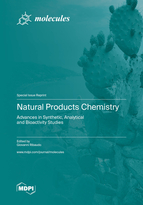Natural Products Chemistry: Advances in Synthetic, Analytical and Bioactivity Studies
A special issue of Molecules (ISSN 1420-3049). This special issue belongs to the section "Organic Chemistry".
Deadline for manuscript submissions: closed (31 July 2023) | Viewed by 28938
Special Issue Editor
Interests: medicinal chemistry; organic synthesis; analytical chemistry; mass spectrometry; NMR; natural products; molecular modeling
Special Issues, Collections and Topics in MDPI journals
Special Issue Information
Dear Colleagues,
The world of chemistry of natural products is endowed with unpaired richness, and this can be noted from several perspectives. Plants, fungi, and marine organisms represent sources of small molecules characterized by a unique complexity due to their variety of scaffolds, functional groups, and stereochemistry. At the same time, extraction, de novo synthesis, derivatization, and semi-synthetic approaches represent challenging tasks for the organic chemist. In parallel, the field of analytical profiling of the content of organic compounds and microelements in natural matrices pushes experimental techniques to the edge of their potential, due to the complexity of sample preparation and data elaboration. Additionally, flavonoids, alkaloids, terpenes, and their semisynthetic derivatives constantly attract the interest of the medicinal chemist in light of their biological roles, which include, among the others, antioxidant, antiproliferative, antibacterial, and anti-inflammatory activities.
This Special Issue aims to collect original contributions describing the extraction, structural elucidation, and synthesis of natural, semisynthetic derivatives and nature-inspired molecules. Moreover, articles reporting the analysis of the content of natural compounds in complex matrices and their bioactivity, as well as review articles focusing on the chemistry of natural products, will be considered. Research articles describing significant results in terms of innovative synthetic and extractive techniques and advanced analysis (chromatography, 1D and 2D NMR, mass spectrometry, IR and UV spectroscopy) are particularly welcome.
Dr. Giovanni Ribaudo
Guest Editor
Manuscript Submission Information
Manuscripts should be submitted online at www.mdpi.com by registering and logging in to this website. Once you are registered, click here to go to the submission form. Manuscripts can be submitted until the deadline. All submissions that pass pre-check are peer-reviewed. Accepted papers will be published continuously in the journal (as soon as accepted) and will be listed together on the special issue website. Research articles, review articles as well as short communications are invited. For planned papers, a title and short abstract (about 100 words) can be sent to the Editorial Office for announcement on this website.
Submitted manuscripts should not have been published previously, nor be under consideration for publication elsewhere (except conference proceedings papers). All manuscripts are thoroughly refereed through a single-blind peer-review process. A guide for authors and other relevant information for submission of manuscripts is available on the Instructions for Authors page. Molecules is an international peer-reviewed open access semimonthly journal published by MDPI.
Please visit the Instructions for Authors page before submitting a manuscript. The Article Processing Charge (APC) for publication in this open access journal is 2700 CHF (Swiss Francs). Submitted papers should be well formatted and use good English. Authors may use MDPI's English editing service prior to publication or during author revisions.
Keywords
- natural compounds
- semisynthetic compounds
- organic synthesis
- analytical chemistry
- flavonoids
- alkaloids
- drug design
- stereochemistry







